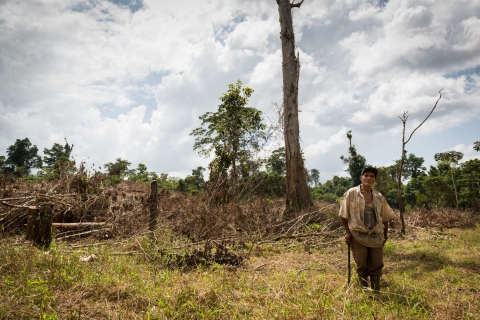
Inside the Bosawás Biosphere Reserve. (Photo by Carlos Herrera)
In Nicaragua, an innovative report on the degradation of an environmental treasure has sparked the public, especially the youth, to take notice.
The story, El ocaso de Bosawás (The Decline of Bosawás), published by Confidencial newspaper in April, is a milestone report on the devastation of Central America’s largest tropical forest, the Bosawás Biosphere Reserve, in northern Nicaragua. The paper told the story through a diversity of multimedia elements, using new technologies and narrative tools. The story features audio, photos, video, maps, timelines and other infographics, in addition to text.
"It was the first big multimedia report ever to be published in Nicaragua," said Confidencial editor Carlos Salinas. What's more, it has been widely shared in the country, especially among youth. The coverage “increased awareness and pressure for the topic," he said. The response has been so positive that Confidencial is planning to launch a micro-site focused on multimedia, data-rich coverage.
The story was made possible through a US$5,000 grant awarded through the multi-year Investigative Reporting Initiative in the Americas 2013-2017, a program of the International Center for Journalists (ICFJ), in partnership with Connectas. Salinas had long wanted to report on the devastation of the Bosawás, but was constrained by the story’s cost.
The grant gave the team the funds to travel to the heart of the jungle on a two-week reporting trip, as well as to hire professionals to manage the technical aspects of the report.
The reserve, once as large as El Salvador, is home to indigenous groups and is rich in biodiversity. It has 279 species of plants, more than 200 kinds of animals and about 200,000 types of insects. Yet it is under threat by powerful economic and political interests. According to Confidencial’s story, the nature reserve is losing about 42,000 hectares (420 square meters) each year. Between 1987 and 2010, the reserve lost more than 564,000 hectares (5,640 square kilometers).
To help the paper show readers the devastation more clearly, the program connected Salinas with Brazilian environmental data journalist Gustavo Faleiros, who was then a Knight International Journalism Fellow. Faleiros had launched InfoAmazonia, a digital map that uses satellite and other publicly available data to monitor the Amazon rainforest. Faleiros helped the Confidencial team use new tools, such as Google Earth and Timeline JS, as well as data sources like protectedplanet.net, a UN global database on protected areas. They determined the size of the reserve, its level of deterioration and the footprint of its indigenous communities. Faleiros also helped the team prepare animated graphics.
The story has called the attention of international environmental groups and the government, which is encouraging youth leaders to advocate for the Bosawás through workshops and educational campaigns.
"[This story] captured national attention because many young readers --and this is really important-- were worried about what’s happening in Bosawás," said Salinas. "We had a lot of interaction with young readers on Twitter and Facebook and the investigation circulated a lot through these networks."
The piece also won the Pedro Joaquín Chamorro Excellence in Journalism Award, the most important of its kind in Nicaragua.
In the video below, Salinas talked with ICFJ about Confidencial’s Bosawás coverage and about his story on Nicaragua’s canal project as it was developing. That story, which also received the support of ICFJ and Connectas, was published November 3.
This video was produced, edited and translated by Jessica Weiss.
Updated: Dec. 8, 2:26 PM EST